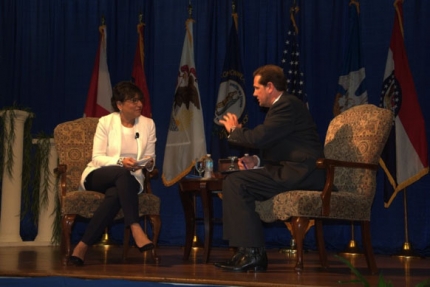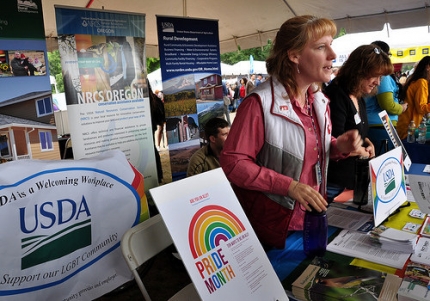Related Rural Blog Posts
Second Made in Rural America Regional Forum Highlights Resources for Rural Delta Businesses
Posted by on July 25, 2014 at 7:29 PM EDTLast week, the White House Rural Council convened the second Made in Rural America Regional Forum to bring together local, state, and federal export-related resources for businesses and community leaders throughout the Mississippi River Delta Region.
The Delta Regional Authority and its state and local partners from Tennessee, Mississippi, and Arkansas hosted the forum at Southwest Tennessee Community College in Northeast Memphis. The Delta region, with its entrepreneurial history, available land, and accessible waterways and transportation network, is primed to reap the benefits of increased exports and participation in exporting.
More than 240 small business owners, industry representatives, community lenders, economic development officials, and community leaders attended the day-long forum. The forum offered business-to-business advice and best practices on expanding into international markets, highlighted financing resources, and facilitated discussion among regional leaders about how to incorporate exports into long-term economic development strategies.
Learn more about RuralMaking the Business Case for Rural America
Posted by on July 25, 2014 at 12:12 PM EDTEd. note: This is cross-posted from the USDA Blog, see the original post here.
These days, it seems like it’s easier than ever to turn a good idea into reality. This is the era of Kickstarter, where entrepreneurs can connect with potential investors at the click of a button.
Of course, it takes more than money to grow an idea. It takes an atmosphere that fosters creativity and rewards innovation. And at a deeper, less obvious level, it requires strong, secure infrastructure—roads and bridges, but also internet access and community facilities like hospitals and schools—that improves connectivity and access to information, moves products to market, and makes communities competitive and attractive to new businesses and investments.
Part of the challenge we face in rural America is that in too many places, infrastructure is outdated and cannot support the same kinds of opportunities that are easily found in cities and larger towns.
Learn more about RuralAddressing the Needs of Working Families in Rural America
Posted by on June 20, 2014 at 11:59 AM EDTThis was originally posted on the Huffington Post, and is part of a series of essays about the issues facing working families, leading up to the White House Summit on Working Families on June 23, 2014.
You can learn more about the Summit and how you can get involved at www.workingfamiliessummit.org.
Last Wednesday, I participated in a regional forum of the White House Working Families Summit that was held at Virginia State University in Petersburg, Virginia. Coming from a small town in Southwest Georgia myself, I can relate to the unique challenges that rural Americans face. Growing up, my father worked seven days a week on our peanut and cattle farm with help from my mother. To make sure our family had a constant source of income and health insurance, my mother also worked off the farm at the local independent bank. I am fortunate to be the product of hard working parents who provided my sister and me with the best opportunities possible.
All families have a right to have access to a good education system, affordable healthcare and jobs. Our rural families are concerned about creating strong prospects for their children, whether it is on or off the farm. But it is also essential that there are opportunities that will attract young people back to rural areas and help us secure the future of agriculture.
The Obama Administration is committed to providing opportunities for working families across the country. That's why earlier this year President Obama created the Made in Rural America Export and Investment Initiative to help rural businesses and leaders take advantage of new investment opportunities and access new markets abroad.
June is Pride Month, National Homeownership Month: USDA Brings Homeownership Assistance to Rural LGBT Communities
Posted by on June 16, 2014 at 4:56 PM EDTEd. note: This is cross-posted on the U.S. Department of Agriculture blog. See the original post here.
June marks the 2014 celebration of Lesbian, Gay, Bisexual, and Transgender (LGBT) Pride Month. USDA is taking this opportunity to recognize the immeasurable positive contributions made by the LGBT community — including our coworkers, partners and clients — to help rural America innovate and thrive, protect our natural resources and promote sustainable agricultural production to help feed the world. In addition, we are demonstrating our commitment to treating our LGBT customers and coworkers fairly and respectfully through educational events, outreach efforts and listening sessions across the country.
June is also National Homeownership Month, and the theme is “Own Your Future. Own Your Home.” With concurrent Pride and Homeownership Month observances, it’s a great time to raise awareness among LGBT communities about USDA home mortgage and home repair programs that can help rural residents own their future.
USDA plays a key role in ensuring low- to moderate-income rural residents have access to affordable home loans. Last year alone, USDA Rural Development provided $23.4 billion for the purposes of purchasing, building, and restoring homes in rural communities. These programs make it possible for low-income rural families to achieve the dream of homeownership. Ensuring that programs like these are accessible to the LGBT community is especially important as a recent study by the Williams Institute finds that LGBT adults are 1.7 times more likely than non-LGBT adults to be living in poverty.
Learn more about RuralLocal Food, Local Places: A Federal Partnership to Help Rural America Use Local Food and Build Local Economies
Posted by on June 9, 2014 at 12:30 PM EDT
Today, the White House Rural Council Chairman USDA Secretary Tom Vilsack announced Local Food, Local Places, a federal initiative providing direct technical support to rural communities to help them build strong local food systems as part of their community’s economic action plans. Under this effort, a team of agricultural, transportation, environmental, and regional economic experts will work directly with local communities to develop comprehensive strategies that use local food systems to meet a variety of needs.
The announcement, made during the White House Rural Council’s first live-streamed meeting, included Vilsack, U.S. Transportation Secretary Anthony Foxx, Environmental Protection Agency Deputy Administrator Bob Perciasepe, Appalachian Regional Commission Federal Co-Chairman Earl Gohl, and Delta Regional Authority Federal Co-Chairman Chris Masingill.
Learn more about RuralRural-Made Goes Worldwide
Posted by on June 6, 2014 at 12:50 PM EDTEd. note: This is cross-posted on the U.S. Department of Agriculture's blog. See the original post here.
This week, I visited Canonsburg, Pennsylvania, a small city outside of my hometown of Pittsburgh, to kick off the first of five Made in Rural America forums designed to help rural small businesses access the information they need to grow through exports.
The global appetite for high-quality, American-made products is well established. Over the past five years, rural America has achieved record agricultural exports, but the rural economy is diverse. Last fiscal year, agricultural exports reached a record $140.9 billion, and we are on track for another record year, with fiscal year 2014 agricultural exports projected to reach $149.5 billion. Last year was also the fourth-straight record-setting year for U.S. exports as a whole, reaching $2.3 trillion.
Yet few American companies today have capitalized on this demand — just one percent of U.S. companies export. At the same time, the vast majority — 95 percent — of the world's consumers live outside the borders of the United States, creating significant opportunities for our exporters, particularly rural businesses.
Learn more about Rural
- &lsaquo previous
- 1
- 2
- 3
- 4
- 5
- 6
- 7
- 8
- 9
- …
- next &rsaquo

